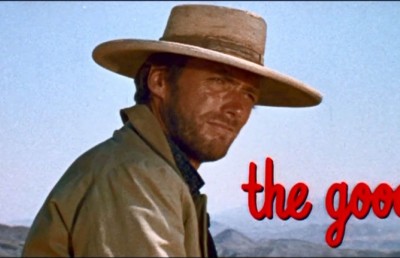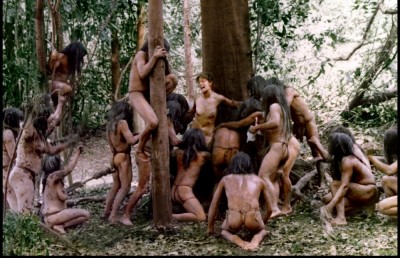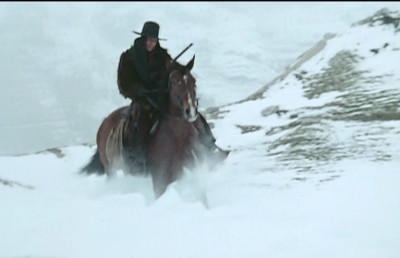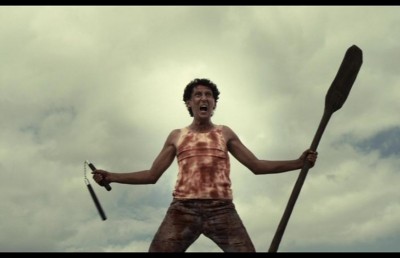Roberto Curti’s Phantom Lovers
The Italian Gothic Explored
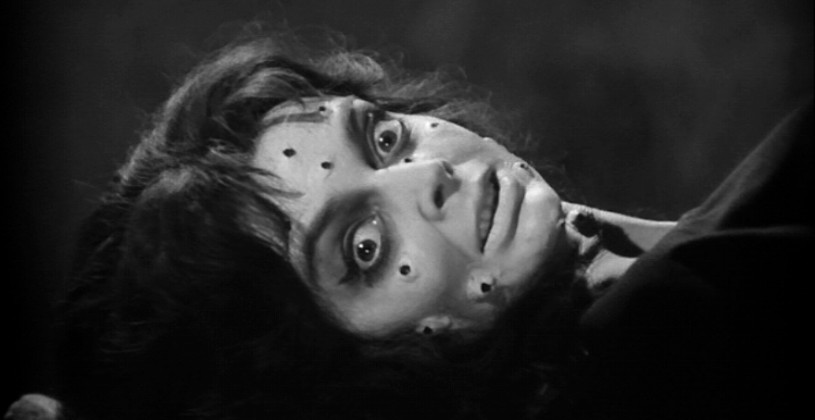
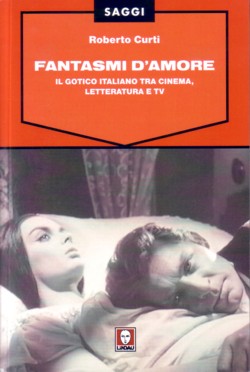
Offscreen regular Roberto Curti is at it again, with yet another book to add to his impressive bibliography. His most recent book (in Italian) treats one of the most fascinating areas of popular Italian cinema, the Gothic. The book’s title, Fantasmi D’Amore: Il Gotico Italiano Tra Cinema, Letteratura E TV (Phantom Lovers: The Italian Gothic Cinema Between Cinema, Literature and Television), was published in 2011 by Lindau publishers. At nearly 500 pages, Fantasmi D’Amore is the final word on a sub-genre of the Italian horror cinema which has produced some of the most iconic, groundbreaking, and influential horror films, by some of Italy’s most respected and followed (by horror fans) horror auteurs, Riccardo Freda, Mario Bava, Antonio Margheriti, Dario Argento, Camilo Mastrocinque, and Pupi Avati. The opening chapter, “Malombre: Il Gotico prima del gotico” (Dark Shadows: The Gothic Before the Gothic (1868-1957) charts the prehistory of the gothic in cinema and literature 1868-1957), beginning with the classics of Italian gothic literature (Malombra by Antonioi Fogazzaro, which Curti posits as the greatest Italian gothic novel (and was adapted into a film in 1942 by Mario Soldati), Beatrice Cenci (1854, Francesco Domenico Guerrazzi), tracing the gothic in silent cinema manifested through the devices of the melodrama, morality and sentimentality. The theme of the fatal woman, for example, cited by Curti (p. 22) in Ma l’amor mio non muore! (My Love will not Die, 1913, Mario Casserini), where the female lead exclaims at the film’s end the ominous note, “L’amo fino alla morte e più in lá” (“I will love you until death, and beyond”); and the lost film from 1920, Il mostro di Frankenstein, by Eugenio Testa (Frankenstein’s Monster). Curti then traces the gothic across later Italian melodrama, like the 1942 Gelosia (Jealousy, Ferdinando Maria Poggioli), where a character is haunted by his tormented conscience after committing a crime of passion (which Curti says has elements of Poe’s Tell-Tale Heart), the same director’s 1944 Il cappello da prete (The Priest’s Hat), and the melodrama which comes closest to the spirit of the gothic, Trovatore (1949, Carmine Gallone).
Chapter two, “La linea gotica (1957-1966)” (“The Gothic Lineage”) takes us head-first into the classic period of 1957-1966. Curti lays out the thematic and stylistic elements of the gothic in this key (2nd) chapter: traits borrowed from gothic literature, from the tradition of the macabre-grotesque, a tendency toward an experimental visual style, the prevalence of a central female character with disturbed psychological tendencies, etc. This chapter contextualizes the Italian Gothic within the films of Hammer and the Corman Poe films. The third chapter, “Finzioni. Dalla pagina allo schermo” (Fiction: From Page to Script”) concentrates on the literary influences of the Italian Gothic, from Poe, Gautier, Maupassant, Le Fanu, E.T.A. Hoffmann, Tolstoi, etc. Curti’s thoroughness is in evidence here when he takes a detour in the sub-section entitled “Spaghetti Pulp” to trace the elements of the gothic across the ‘feuilleton’ (comic strips) published starting in 1899 in the newspaper “Domenica del Corriere” and then in other sources. Chapter 4, one of the most fascinating, given the formal inventiveness of many of these films, looks at the temporal and spatial qualities of the Gothic (“Paessaggi (e) immaginari. Tempo e luoghi del gotico italiano” (“Landscapes (and) imaginary. Time and place of the Italian Gothic”). Curti covers his theoretical ground well too, by including the sub-section on Tzvetan Todorov’s seminal thoughts on The Fantastic, “Esserre e non esserre: il gotico e il fantastic” (“To be or not to be: the gothic and the fantastic”). The Freda classic L’orribile segreto del dr. Hichcock (The Horrible Case of Dr. Hichcock), perhaps the single masterwork of Italian gothic cinema (along with Bava’s La maschera del demonio) is justly given ample coverage (along with Bava’s Operazione paura (Kill Baby Kill) in this chapter.
Chapter five charts one of the most distinctive and transgressive aspects of the Italian Gothic, “Le regole dell’attrazione. Erostismo e perversione nel gotico italiano” (“The rules of attraction: eroticism and perversion in the Italian Gothic.” Unsurprisngly, Bava’s necrophilic masterpiece The Whip and the Body is one of the films that takes center stage in this chapter, along with other films that deal with sexual perversions, Danza Macabra, I lunghi capelli della morte, and Il Mulino delle donned i pietra. Issues of censorship and religion are dealt with in this chapter.
Chapter six, “On oscuro scrutare. Forme, meccanismi, influenza del gotico anni ‘60” (“An Investigation into the Obscure: Form, Mechanisms, and the Influence of the 1960s Gothic”), returns to formal and stylistic aspects of the Gothic cinema. This includes a fascinating discussion of the importance of the zoom in the gothic aesthetic, largely because the genesis of gothic cinema coincided with the diffusion and incorporation of the zoom lens into the Italian industry by the end of the 1950s (p. 173). Curti gives scene descriptions of its effective use by Freda, Bava and Mastrocinque. When abused as a time and money saving device (avoiding costly setups for tracking and dolly shots) the zoom can become a lazy device and counterproductive; but Curti argues that in the hands of said masters, the zoom is an effective addition to the Italian gothic template, underscoring moments of fear, shock, surprise, or conflating two shots into one, or as a transitional device between scenes. As Curti writes, “Lo zoom fornisce anche il corrispondente visivo di quelta tendenza all’iperbole a all’esclamazione violente che è uno dei tratti stilisitici portanti della peotica gotica”: come osservava Foucault ‘il linguaggio del terrore è votato a un dispendio infinito, nel momento stesso in cui si propone di non raggiungere che un effetto’” (“The zoom also provides the corresponding visual of the tendency toward hyperbole and violent exclamation that is one of the defining stylistic elements of the gothic poetry: as observed by Foucault ‘the language of terror is devoted to an infinite expenditure, at the same time in which the proposed effect can’t be reached’ “ (p. 174). Fittingly, given his impressive command of the visual aspect of cinema, the films of Mario Bava are given special treatment in this chapter, as well the important contributions of Antonio Margheriti. This chapter provides some of the best written analysis I’ve read of what can be termed the Freda/Bava filmic. This chapter (6) concludes with the important contributions of non-Italians in the sub-section entitled “Strangers in a Strange land,” a reflection of the fact that Italy was the hub of International and co-production filmmaking in the 1950’s and 1960s.
Offshoots and one-offs are dealt with in Chapter 7, “Eretici ed ecentrici” (Inheritors and Eccentrics). The interesting case of Fellini forms much of this chapter, and there is also room for the unique contributions of Pupi Avati, nicknamed for his regional eccentricities of shooting in the town of Emilia-Romagna, the “Padano Gothic” (lovers of cheese will think about the ‘grana padano’). Chapter 8 steps beyond the key period of the 1960s into the 1970s. The ever changing and pliable nature of the Italian popular film, the filone, is on evidence here in the way Curti looks at the cross-pollination of the gothic with the giallo and the crime film. Dario Argento makes his entrance in this chapter, with his film Deep Red, and the chapter sees the return of Mario Bava to the gothic genre after a hiatus of six years, with Baron Blood and his late masterpiece Lisa and the Devil. Curti’s breadth of research and critical smarts leads to some interesting insights, such as his clever linkage of Lisa and the Devil with the episode in Twilight Zone, “After Hours” in which Anne Francis plays a woman experiencing a disquieting afternoon in a large department store, with the kicker twist that she is a store mannequin who had a brief moment of human transience. Curti notes how the twist ending echoes that of Lisa nd the Devil??’s, in the way the Elke Sommer character comes to the self-realization at the end that she had been living a life caught in a state of limbo between the living and the dead (revealed as she finds herself trapped on an plane populated only by the corpses of the characters she encountered in the narrative, captained by the devil/trickster figure of Teddy Savalas). As an additional note, I would add that the more direct influence on this ending is the original but shelved ending of Fellini’s ??8 1/2, where the Mastroianni character Guido Anselmi boards an eerie train filled with the ghosts of his life (the intriguing links between Fellini and Italian horror is an essay that has been germinating in my head for a long while and will certainly surface one day in these pages!). Curti also points to the possible influence of another Twilight Zone episode, “Third From the Sun,” on the ending of Bava’s horror-science-fiction gothic, Terror e nello spazio??/ ??Planet of the Vampires. Bava’s Shock is interestingly referred to as a “gothic without any gothic” (p. 346). Argento’s unique gothic duo of Suspiria and Inferno close off the chapter (pages 358-365).
The penultimate chapter crosses mediums by looking at how the gothic was channeled into television, “Il gotico television (1969-1980)”. This chapter will no doubt be unfamiliar to non-Italian readers since the shows discussed aired in Italy and have not had the same exposure outside Italy (through either home video release or auxiliary theatrical venues). Some fans of Italian horror may be surprised (and pleased) to discover that Mario Bava co-directed his last work (a short feature) with his son Lamberto, starring Dario Nicolodi, for Italian television in 1978, La Venere d’Ille (The Venus of Ille). Another established film director to have worked on TV was Giulio Questi (Death Laid an Egg, 1968, Arcana, 1972), with the German E.T.A. Hoffman adaptation, Vampirismus. The book concludes with a fifty plus page overview of the subject from the 1980s to the present day (including television). Appearing in this chapter are the key figures one would expect: Damiano Damiani, Lucio Fulci, Luciano Martino, Lamberto Bava, Argento, Sergio Stivaletti, Michele Soavi. Happily, one of my favorite Italian films of the period, Soavi’s Dellamorte Dellamore is given is due justice as a masterpiece of postmodern fantastic cinema (a film that really defies easy explanation). In the concluding section on the gothic today Curti gives a most thorough analysis of Argento’s conclusion to the Mother’s trilogy, La terza madre and gives a fair assessment of its strengths and weaknesses in relation to his own works and gothic horror in general. Curti appreciates the film’s varied inter-textual references to his own works and other classic Italian works, while lamenting the absence of the gothic sensibility of death at once macabre and beautiful that was a signature of the first two films of the Mothers trilogy. Unlike most reviewers who see the film’s camp sensibility and over-the-top gore as a sign of outright aesthetic failure, Curti acknowledges the possibility that Argento may be (consciously or not) falling into what Curti, quoting Leslie Fielder, defines as “the gothic as parody and exaggeration of clichés to the limit (and beyond) of the grotesque” (p. 429). Interestingly, Curti see La terza madre as being closer to the delirium of José Mojica Marins than the abstractness of Inferno (p. 429). As an added curio element to Curti’s comparison, like Argento (1980 to 2007), Marins had also recently completed a trilogy after a long hiatus (1966 to 2007).
In the epilogue Curti proposes some concluding statements and observations on the role and function of the gothic. As an example, Curti writes,
Se consideriamo la rappresentazione dell’orrore, al cinema come in letteratura, come [quoting David Punter’s seminal study of the Gothic, The Literature of Terror: A History of Gothic Fictions from 1765 to the Present Day 1980] ‘una forma –per non dire la forma– della storia non ufficiale’, ovverosia uno sbocco per rapresentare una visione del mondo che fugga dai parametri del realism, le vicende del gotico italiano possono essere lette come una trasfigurazione… di mutamenti, paure, dubbi e pregiudizi legati alle vicende di un paese in mutamento: dalla condizione della donna alla dissoluzione del patriarcato, dallo scollamento generazionale in atto al rapido mutamento dei costumi” (443-444).
If we consider the representation of horror, in the cinema as well as literature, as [quoting David Punter’s seminal study of the Gothic, The Literature of Terror: A History of Gothic Fictions from 1765 to the Present Day 1980] ‘a form –if not the form’– of the unofficial story’, as representing an outlet for a vision of the world that shuns the parameters of realism, the events of the Italian gothic can be read as a transfiguration….of changes, fears, doubts and prejudices related to the events of a country in transition: from the condition of women, to the dissolution of patriarchy, to a general sense of detachment in face of rapid change in customs and manners.
Over the passing centuries of change and transfiguration the gothic remained forever tied to three crucial themes: paranoia, barbarism and the taboo (p. 444). In the final paragraphs Curti outlines how the recurring themes and concerns of the gothic continue to hold sway in more recent Italian cinema, pointing to Matteo Garrone’s “solipsistic-erotic” Primo amore (2004) and the “existential-horror” film (based on a best-selling novel) by Saverio Costanzo La solitudine dei numeri primi (The Solitude of Prime Numbers, 2010). Curti draws parallels between one of the first great Italian gothic films, Bava’s La maschera del demonio (The Mask of Satan??/ ??Black Sunday, 1960) and Garrone’s Primo amore, in the continuing attraction-repulsion emotive of the female corpse, “object of desire and repulsion” (p. 448). With the passing decades the shape of the horrific has changed, from Barbara Steele’s attractive-turned-puss-filled demon face to Garrone’s Sonia, a slender woman who turns sickly emaciated after she succumbs to her sick boyfriend’s obsession with thinness. The shift gives fruit to the sort of broad social changes charted above, and wonderfully examined by Curti in a book which is slated to be the final word on its subject. The book also includes a nice middle section of black and white film stills and a useful bibliography of essential material. As someone who can read Italian, I lament the lack (as of yet) of a translation of this book into English (as well Curti’s other published works) because I realize the wealth of knowledge, research and insight that English reading fans of Italian horror would benefit greatly from.



